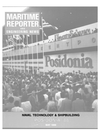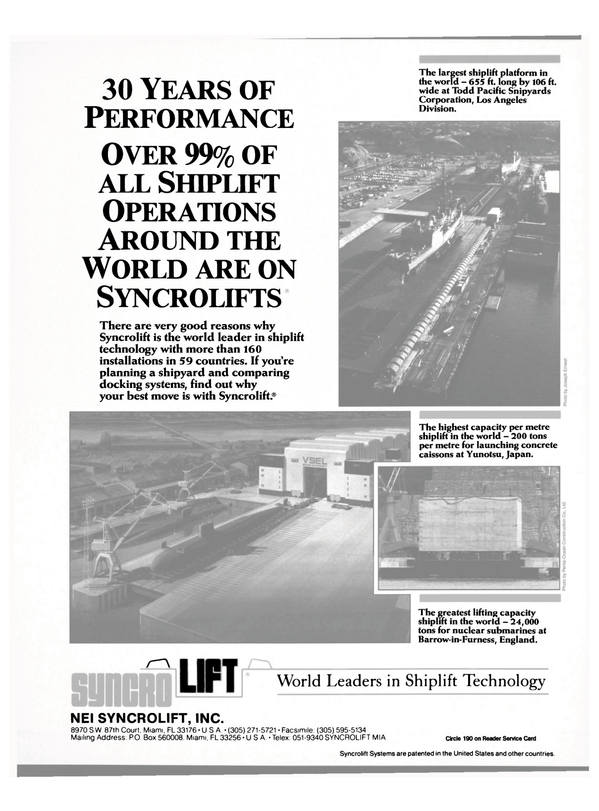
Future Business Opportunities In Navy Ship Procurement, Ship Maintenance And Navy Technology Development
International Maritime Associates, Inc. (IMA) prepares detailed business reports covering the U.S.
Navy market. They deal with future business opportunities available to shipyards, manufacturers, engineering firms and other marine suppliers.
This article is based on information contained in recent reports.
Overview The U.S. Navy is the major generator of work for shipyards and marine equipment manufacturers in this country. Total spending on new ship procurement has averaged $10.8 billion per year over the past 10 years. This includes spending for ships systems and weapons, as well as the ship. Spending on ship maintenance and modernization has averaged $4.7 billion per year this period. Spending on new naval technology development has averaged $7.6 billion. Details are shown in Exhibit 1.
Ship Procurement As of early March, 90 naval ships were on order in 17 shipyards. Major players include Newport News (aircraft carriers and attack submarines), General Dynamics-Electric Boat (Trident and attack submarines), Ingalls (Aegis combatants and LHDs), Bath Iron Works (Aegis combatants) and Avondale (fleet oilers and LSDs). These and other shipyards currently building naval ships are shown in Exhibit 2.
The Navy plans to spend more than $25 billion on ship construction over the next two years. This year's budget is $16.2 billion—a major portion of which is represented by funding for two new aircraft carriers, three attack submarines, one Trident submarine and five Aegis cruisers. The FY 1989 budget request is $9.1 billion. Details for ship construction planned over the next five years are shown in Exhibit 3.
Continuing coverage of this area is provided in IMA's quarterly busi- ness report U.S. Navy Ship and Equipment Procurement.
Ship Maintenance During FY 1987, 45 commercial shipyards received contracts for Navy ship repair and maintenance.
Ship repair work was also performed in the eight naval shipyards and three Navy-owned ship repair facilities. Details for ship repair contracts in progress in commercial yards as early March 1988 are shown in Exhibit 4.
Spending for ship maintenance and modernization is projected to exceed $9.4 billion over the next two years. This year the Navy plans to spend $4.7 billion to perform 27 overhauls and 151 short term availabilities (SRA's/PMA's). In FY 1989 projected spending is $4.8 billion— to perform 23 overhauls and 158 short term availabilities. Budget details are shown in Exhibit 5.
Continuing coverage of this area is provided in IMA's quarterly business report U.S. Navy Ship Maintenance and Modernization.
New Naval Technology —$9.5-Million Annual Market For Marine Suppliers Hundreds of companies are involved in Navy-sponsored research and development. Many companies have used the Navy R&D program to establish early position for major future procurements. Current work encompasses virtually the entire spectrum of new technology—from advanced composites and supercomputers to new propeller designs and electric drive propulsion systems.
In FY 1988 spending for Navy technology development will exceed $9.5 billion. Next year the technology development budget is projected to be $9.2 billion.
Shown in Exhibit 6 are some of the major technology development programs planned in FY 1988 and 1989. These and more than 200 other technology development programs are detailed in IMA's new report The New Naval Technology Program—A Detailed Guide to $9.5 Billion in New Annual Sales for Manufacturers, Engineering Firms and Suppliers.
Read Future Business Opportunities In Navy Ship Procurement, Ship Maintenance And Navy Technology Development in Pdf, Flash or Html5 edition of May 1988 Maritime Reporter
Other stories from May 1988 issue
Content
- Blount Marine To Build Another New York-Class Harbor Cruise Vessel page: 4
- Krupp Mak Manufactures Medium-Speed Diesel Engines For Naval Ship Applications page: 6
- Burmeister & Wain Christens Eighth Product Tanker In Series page: 7
- RORO88 9th International Conference & Exhibition on Roll-On/Roll-Off Marine Transport page: 8
- ITW Philadelphia Resins Offers Color Brochure On Grouting Systems page: 11
- Mizell Named Vice President-Sales At Trinity Marine Group page: 12
- Society Of Marine Port Engineers Holds 36th Annual Forum—Five Technical Papers Featured page: 13
- Posidonia The International Shipping Exhibition page: 14
- Sperry Marine GPS Core Module And 501TR/GPS Navigator Offer Reliable, Accurate Performance page: 19
- Bethlehem Steel Consolidation At Sparrows Point Strengthens Competitive Position page: 20
- Norwegian-Built Training Simulator Installed At French Maritime College page: 21
- Shipbuilders Council Elects Board Members page: 22
- Schottel Offers Free Color Brochure On Its 'Rudderpropeller,' And Units For Shallow-Draft Propulsion page: 22
- JJH Inc. Expands CADAM To Portsmouth Location page: 22
- Future Business Opportunities In Navy Ship Procurement, Ship Maintenance And Navy Technology Development page: 25
- MAJOR NAVY CONTRACTS page: 29
- $116-Million Contract To Tacoma Boat To Retrofit Four Egyptian Subs page: 37
- SNAME SPRING MEETING/ STAR SYMPOSIUM 'MARINE & OFFSHORE SYSTEMS' page: 38
- Megator Completes Navy Pump Contracts Totaling $1.3 Million page: 40
- McDermott Names Howson To Succeed Cunningham As Chief Operating Officer page: 43
- Wartsila Constructing Two Passenger Vessels For Oy Silja Line Ab page: 43
- New York Exhibition Showcases First Production Color ARPA From Racal Marine page: 44
- Parker Towing Announces Administrative Changes page: 47
- New Computerized System Controls Fuel Viscosity page: 47
- N e w Gladding-Hearn-Built High-Speed Catamaran To Begin Boston/Martha's Vineyard Run page: 48
- Bird-Johnson Named Exclusive U.S. Service Representative For Blohm + Voss Simplex Line page: 55
- SSPA Maritime Consulting Offers Brochure On Roll Reduction By Rudder Control page: 55
- Alfa-Laval Offers New 8-Page Brochure On Full Customer Services page: 56
- Ulstein Offers Free Color Brochure On High Lift Rudder page: 57
- Caterpillar Publishes 40-Page Color Booklet On Diesel Fuels/Engines page: 57
- Kobelt's 2-Station Control System Is Simple In Design, Durable In Construction page: 58
- Port Of Portland Dedicates $46-Million Terminal 2 Rehabilitation Project page: 58
- Soundcoat Introduces Custom-Cut Closed Cell Foam Materials For Gasketing page: 62


